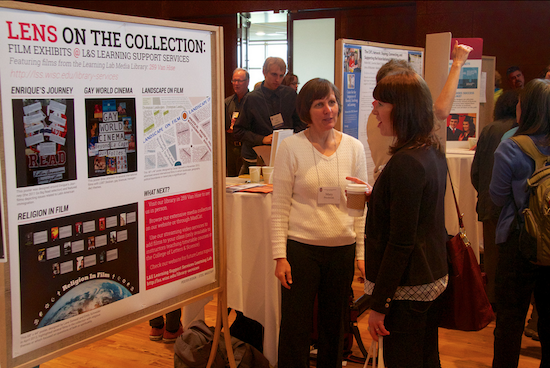Brick-and-mortar teaching meets high-tech innovation: Sparks fly

Theresa Pesavento, L&S Learning Support Services, talking with a visitor to her poster about media support and resources for instruction.
Photo: Alan Wolf
For fifteen years, the UW Teaching and Learning Symposium has been the go-to place for UW instructors to share their findings and learn new teaching strategies.
This year’s symposium was the largest yet, with nearly 600 registrants, 39 scholarly posters, 25 workshops, and five plenaries woven into a day-and-a-half event. It’s no surprise that the symposium theme, Sparking Innovation: Ideas to Impact, drew dozens of high-tech ideas for the college classroom. But some of the best energy came from the mash-up where those new technologies met teaching methods deeply rooted in learning.
It’s a new era, declares Christopher Olsen, interim vice provost for teaching and learning. “We all know the global reach of the research produced at this university. What people may not know is that we also uphold high standards of excellence for teaching. This year’s symposium brought to light a staggering number of innovations happening right now, all across campus. UW–Madison’s commitment to teaching is impossible to miss.”
From massive open, online courses (MOOCs) to mobile iPad kits to reimagining how students work in groups, UW–Madison boasts tremendous support for educational innovations.
Where can all of these teaching innovations be found? The answer is everywhere. Here are examples of the many takeaways from the symposium:
Flip your classroom: Deliver content online during traditional homework time, and then use the in-class meeting time to solve challenging problems with authentic applications.
Enhance your classrooms with digital media resources: DoIT Academic Technology, Learning Support Services, and the Digital Media Center.
Try using technologies you already know in new ways: Reconfigure student group work with Google Docs; create and use rubrics embedded in Learn@UW; and reimagine how to use PowerPoint with multiple screens.
Design for “unsettled” spaces or introduce “making” in which students create and contribute new knowledge.
Apply lessons from studies around literacy and gaming.
Reimagine writing assignments and group work.
Schedule reciprocal classroom visits with another professor or TA to review your teaching.
Stuck without resources for a lab? Try a virtual online lab or a FIG.
Underlying all the innovations and scholarship around teaching and learning, the conference promoted an important message: Some of the best inspiration is happening right down the hall from you, in a professor’s office or a TA’s classroom.
Check out the entire program from the 2013 symposium to find someone you know who is doing some creative, scholarly work in teaching and learning. You’ll find cross-campus inspiration, ideas, and solutions, along with abstracts and information for all the sessions. Contact the people who are doing work in the areas you’re interested in.
“The energy was absolutely palpable this year,” Olsen adds. “I felt a strong sense that the focus on student learning is really permeating the campus, and that the Educational Innovation effort is beginning to dig deep and gain traction. I feel incredibly privileged to work with colleagues across the campus who are so committed to educational excellence.”
—Sarah Miller




